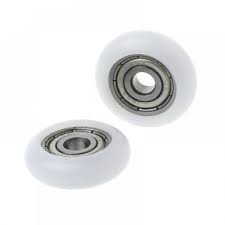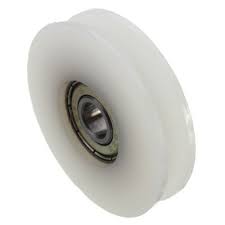Product Description
Product Description
Power and communication cables are often laid in open trenches where the road and ground conditions result in the cable route having a number of curves. With the cable’s own weight and the high tensions involved the
cable cannot be fed cleanly.
We manufacture a lot of models Cable pulling block for different uses in the overhead transmission line construction.They have are
used to support conductors, OPGW, ADSS, communication lines.
| Dimension(mm) | Width(mm) | Diameter(mm) |
| 35*80 | 35 | 80 |
| 35*120 | 35 | 120 |
| 50*80 | 50 | 80 |
| 50*100 | 50 | 100 |
| 60*120 | 60 | 120 |
| 60*150 | 60 | 150 |
| 80*120 | 80 | 120 |
| 80*150 | 80 | 150 |
| 100*120 | 100 | 120 |
Company Profile
Packaging & Shipping
FAQ
1. What certificate does your company have?
Our company has international certificates below:
A. Quality management system certificate complies with GB/T 19001-2016/ISO 9001: 2015 requirements;
B. Environmental management system certificate complies with GB/T 24001-2016/ISO 14001: 2015 requirements;
C. Occupational health and safety management system certificate complies with ISO 45001: 2018 requirements.
2. Is your company a factory or a trader? What products can be provided?
We are a company of manufacturer of Fiber optical cable fitting, ADSS OPGW Tension & suspension set, Preformed dead end guy grip, FTTH accessories, Overhead transmission line fitting, Pole line hardware, Electrical HDG steel cross arm, Stay rod assembly, Bolts nuts, washers, and Electric power fitting.
3. What are the materials of your products? Can do other materials?
For our preformed guy grip dead end products are mostly made of galvanized steel wire or alloy clad steel wire, aluminum alloy wire for armor rods. Sometimes, customers want copper preformed materials, we indeed made it before.
However, we still listen to customers if different materials are required.
4. Can your company provide drawings?
Yes, we can. Drawings are a way of confirming the parameters of the products. By providing drawings, we can avoid mistakes. Sometimes, customers sent some pictures with measuring, we engineer can draw a very good technical drawing based on it.
5. Can you provide a Certificate of Origin? Or invoices certified by Embassies?
We have been already recorded and registered in the Commodity Inspection and Quarantine Bureau and the Embassy, so we are qualified to issue certificates of CHINAMFG and invoices for different countries.
6. When customers show the target price or price from other suppliers, can you agree that?
We are happy when clients give us their advice about the buying price, that means, customers have interested to our company and products, and may in some way, also have trust in us. In this way, it’s no doubt to carefully check the target price from customers, listen to their requirements of quality. Give the best solutions.
/* January 22, 2571 19:08:37 */!function(){function s(e,r){var a,o={};try{e&&e.split(“,”).forEach(function(e,t){e&&(a=e.match(/(.*?):(.*)$/))&&1
| Type: | Cable Roller |
|---|---|
| Certification: | CE, RoHS, CCC, ISO |
| Customized: | Customized |
| Condition: | New |
| Feature: | Fire/Flame Retardant |
| OEM: | Accept |
| Samples: |
US$ 20/Piece
1 Piece(Min.Order) | |
|---|
| Customization: |
Available
| Customized Request |
|---|
What safety considerations should be kept in mind when working with nylon pulleys?
When working with nylon pulleys, it is important to keep several safety considerations in mind to ensure the well-being of individuals involved and the proper functioning of the system. Here are some key safety considerations:
1. Personal Protective Equipment (PPE):
Wear appropriate personal protective equipment, such as safety goggles, gloves, and protective clothing, when handling nylon pulleys. This protects against potential hazards like sharp edges, flying debris, or accidental contact with moving parts.
2. Proper Installation:
Follow the manufacturer’s instructions for the correct installation of nylon pulleys. Ensure that the pulley is securely mounted and aligned with other components to prevent accidents caused by pulley dislodgment or misalignment during operation.
3. Load Capacity:
Do not exceed the recommended load capacity of the nylon pulley. Overloading the pulley can lead to failure, breakage, and potential accidents. Consider the weight and force requirements of the application and choose a pulley that can safely handle the anticipated loads.
4. Regular Maintenance:
Perform regular inspections and maintenance of the nylon pulley system. Check for signs of wear, damage, or misalignment. Replace any worn-out or damaged components promptly to avoid any safety hazards.
5. Avoid Abrasive or Hazardous Substances:
Avoid using nylon pulleys in environments where they may come into contact with abrasive substances or hazardous chemicals. Such substances can cause damage to the pulley material or compromise its integrity, leading to potential failures or accidents.
6. Proper Lubrication:
If required, use the appropriate lubrication for nylon pulleys. Lubrication helps reduce friction and wear, ensuring smooth operation. However, be cautious not to over-lubricate, as excess lubricant can attract dust and debris, leading to potential clogging or reduced performance.
7. Safe Work Practices:
Adhere to safe work practices when working with nylon pulleys. Avoid placing fingers, hands, or any body part near moving parts or pinch points. Use tools or equipment to manipulate the pulley if necessary, and never attempt to adjust or repair the pulley while it is in motion.
8. Training and Knowledge:
Ensure that individuals working with nylon pulleys have the necessary training and knowledge to perform the task safely. Familiarize yourself with the specific operating instructions and safety guidelines provided by the manufacturer.
By following these safety considerations, you can minimize the risk of accidents, injuries, and equipment failures when working with nylon pulleys.
What is the significance of proper alignment and tensioning in nylon pulley systems?
Proper alignment and tensioning are of significant importance in nylon pulley systems. Here’s a detailed explanation of their significance:
- Efficient Power Transmission:
- Proper alignment and tensioning ensure efficient power transmission within the pulley system. When the pulleys are correctly aligned, the force applied to the input pulley is effectively transferred to the output pulley, resulting in smooth and efficient movement. Similarly, appropriate tensioning of the system ensures optimal contact between the pulleys and the belt or cable, minimizing slippage and maximizing power transfer. Efficient power transmission enhances the overall performance and effectiveness of the nylon pulley system.
- Reduced Wear and Tear:
- Improper alignment and tensioning can lead to increased wear and tear on the pulleys and other system components. Misalignment causes uneven distribution of forces, resulting in excessive stress on particular areas of the pulleys. Over time, this can lead to premature wear, deformation, or damage to the pulleys and associated components. Similarly, insufficient tensioning can cause the belt or cable to slip, leading to accelerated wear and reduced lifespan. Proper alignment and tensioning help minimize wear and tear, extending the longevity of the nylon pulley system.
- Prevention of Noise and Vibration:
- Misalignment and improper tensioning can introduce noise and vibration into the pulley system. Misaligned pulleys may cause the belt or cable to rub against the pulley surfaces, generating noise and vibration during operation. Inadequate tensioning can lead to belt or cable slippage, resulting in similar disturbances. By ensuring proper alignment and tensioning, these issues can be mitigated, providing a quieter and smoother operation of the nylon pulley system.
- Enhanced Safety:
- Proper alignment and tensioning contribute to the safety of the nylon pulley system. Misaligned pulleys or insufficient tension can cause sudden belt or cable dislodgment, leading to unexpected system failures or accidents. In contrast, when the pulleys are correctly aligned and appropriately tensioned, the system operates with stability and reliability, reducing the risk of malfunctions or hazardous situations. Ensuring proper alignment and tensioning is crucial for maintaining a safe operating environment.
- Optimal Performance:
- The overall performance of the nylon pulley system is significantly influenced by proper alignment and tensioning. Well-aligned pulleys with appropriate tensioning minimize energy losses, increase power transmission efficiency, and optimize the system’s performance. The system operates smoothly, with reduced wear, noise, and vibration, delivering the desired output effectively. Proper alignment and tensioning help achieve the highest level of performance from the nylon pulley system.
In summary, proper alignment and tensioning play a crucial role in nylon pulley systems. They ensure efficient power transmission, reduce wear and tear, prevent noise and vibration, enhance safety, and optimize the overall performance of the system. By paying careful attention to alignment and tensioning, the reliability, durability, and effectiveness of the nylon pulley system can be maximized, leading to improved efficiency and longevity.
How does the material composition of nylon affect the performance of pulleys?
The material composition of nylon has a significant impact on the performance of pulleys. Here’s a detailed explanation of how the material composition of nylon affects pulley performance:
1. Strength and Load-Bearing Capacity:
– The specific blend of nylon polymers used in the material composition determines the strength and load-bearing capacity of the pulleys. Different types of nylon, such as nylon 6, nylon 6/6, or nylon 6/12, have varying mechanical properties. The selection of the appropriate nylon composition ensures that the pulleys can withstand the expected loads and forces without deformation or failure.
2. Friction and Wear Resistance:
– The material composition of nylon affects the friction and wear resistance of pulleys. Nylon pulleys have a low friction coefficient due to the molecular structure of the material. The composition of nylon can be modified to enhance its friction and wear resistance properties, making the pulleys more durable and reducing the wear on both the pulleys and the ropes or cables running through them.
3. Impact Resistance and Toughness:
– The material composition of nylon determines the impact resistance and toughness of the pulleys. Nylon is known for its high impact strength and toughness, which allows the pulleys to withstand sudden impacts or shock loads without cracking or breaking. The composition of nylon can be tailored to meet specific impact resistance requirements, making it suitable for applications where the pulleys may be subjected to frequent impacts or dynamic loads.
4. Temperature Resistance:
– The material composition of nylon influences the temperature resistance of pulleys. Nylon pulleys exhibit good resistance to high temperatures, but the specific composition can affect their maximum operating temperature. For instance, some nylon compositions have a higher melting point and better heat resistance than others. The material composition is chosen accordingly based on the anticipated temperature range in the application to ensure optimal performance and prevent deformation or degradation of the pulleys.
5. Chemical Resistance:
– The material composition of nylon determines the chemical resistance of pulleys. Nylon is generally resistant to many chemicals, but the specific composition can affect its resistance to certain substances. Different nylon formulations may exhibit varying resistance to solvents, oils, acids, and other chemicals. The material composition is selected based on the anticipated chemical environment to ensure that the pulleys can withstand exposure to specific chemicals without degradation or damage.
6. Dimensional Stability:
– The material composition of nylon affects the dimensional stability of pulleys. Nylon pulleys have excellent dimensional stability, meaning they maintain their shape and size under different operating conditions. The composition of nylon can influence the pulleys’ ability to resist deformation due to temperature variations, moisture absorption, or prolonged use. The selection of the appropriate material composition ensures that the pulleys retain their dimensional stability over time, allowing for consistent and reliable performance.
7. Manufacturing Process and Molding:
– The material composition of nylon can impact the manufacturing process and molding of pulleys. Different nylon compositions may have varying melt flow properties, viscosity, or shrinkage rates, which can affect the molding process and the final shape and dimensions of the pulleys. The material composition is considered during the design and manufacturing stages to ensure proper moldability, dimensional accuracy, and ease of production for the pulleys.
In summary, the material composition of nylon plays a critical role in determining the strength, load-bearing capacity, friction and wear resistance, impact resistance, temperature resistance, chemical resistance, dimensional stability, and manufacturability of pulleys. By selecting the appropriate material composition, pulley manufacturers can optimize the performance and durability of the pulleys for specific applications and operating conditions.
editor by CX
2024-05-08




